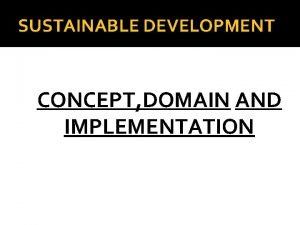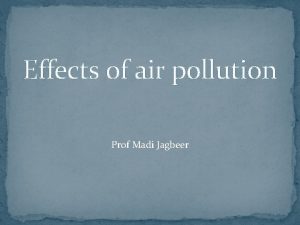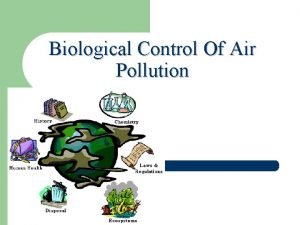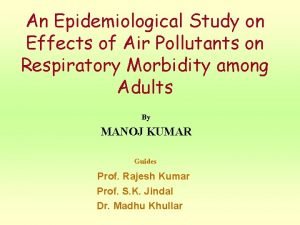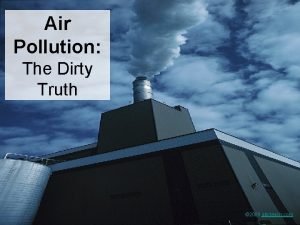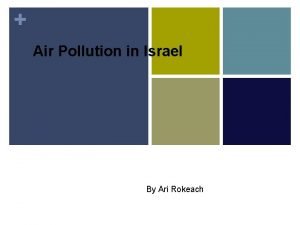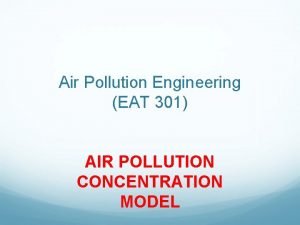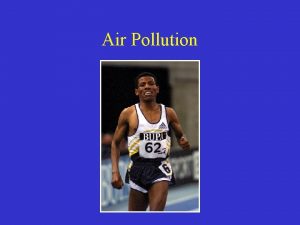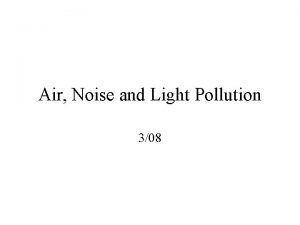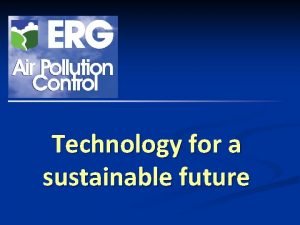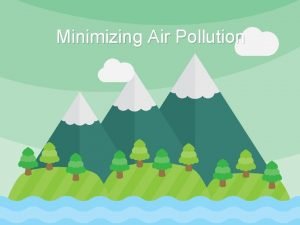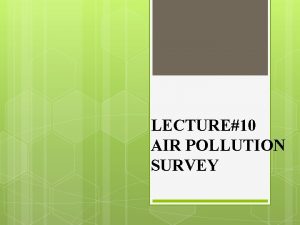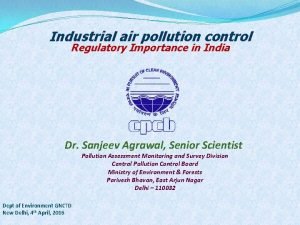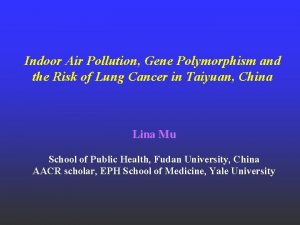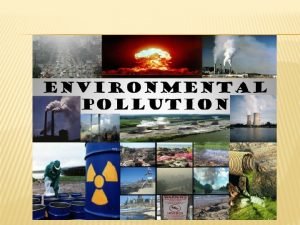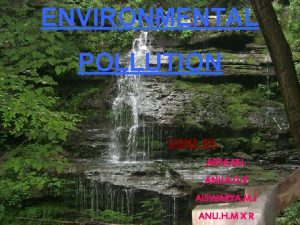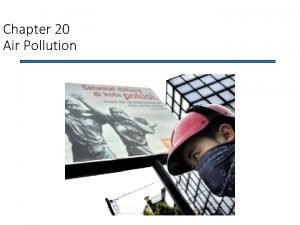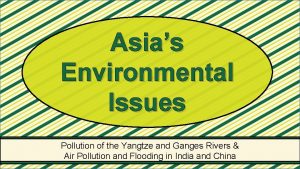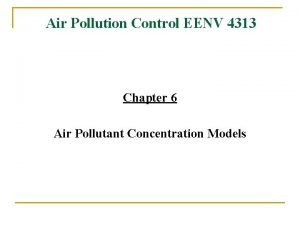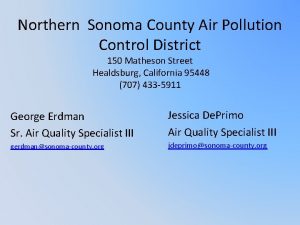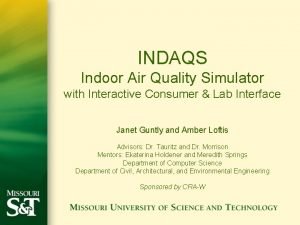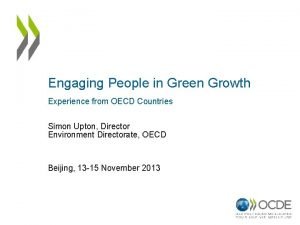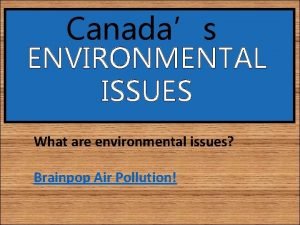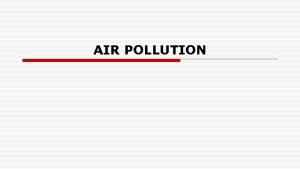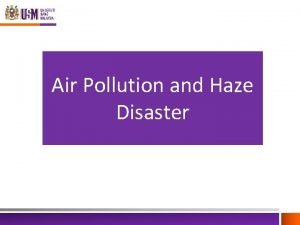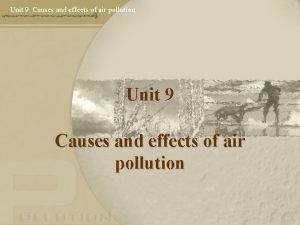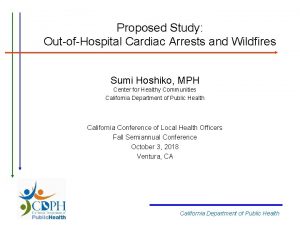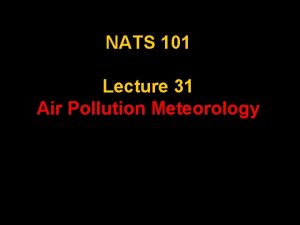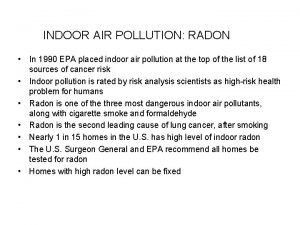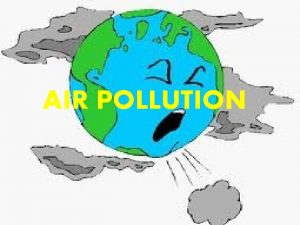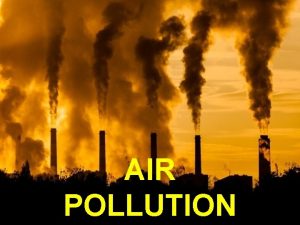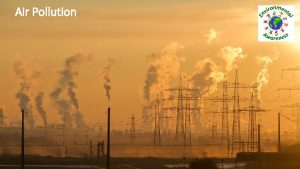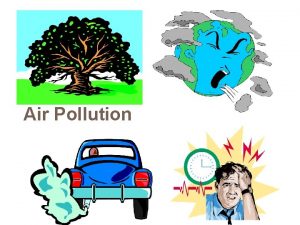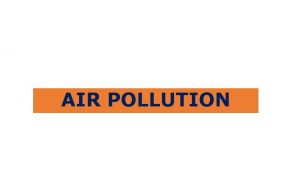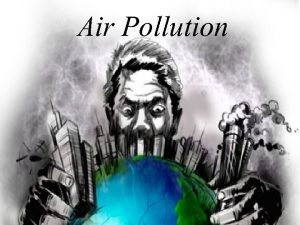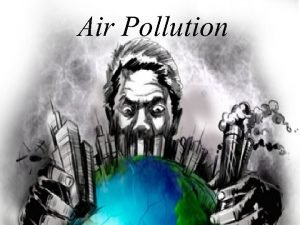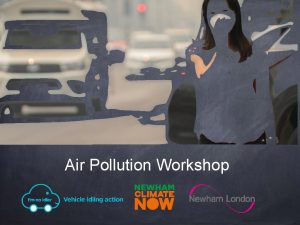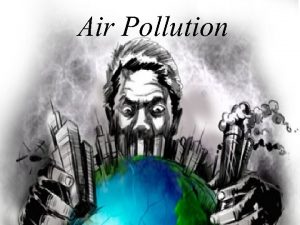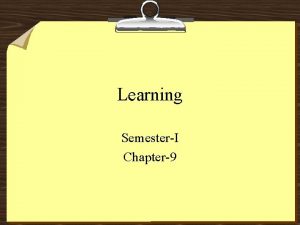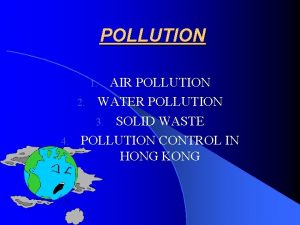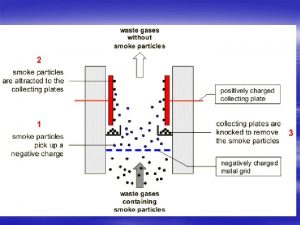CHAPTER9 AIR POLLUTION AIR POLLUTION DEFINITION AIR POLLUTION






































- Slides: 38

CHAPTER-9: AIR POLLUTION

AIR POLLUTION DEFINITION Ø AIR POLLUTION : -Means any solid , liquid, or gaseous substance ( including noise ) present in the atmosphere in such concentration as may be or tend to be injurious to human beings or other living creatures or plants or property or environment Ø AIR POLLUTANT : -the substance which creates pollutant is called pollutant

AMBIENT AIR QUALITY STANDARDS

AMBIENT AIR QUALITY STANDARDS

CLASSIFICATION OF AIR POLLUTANTS v A - Classification based on origin of pollutants : 1) PRIMARY POLLUTANT 2)SECONDARY POLLUTANT 1) Primary Pollutant: - - Emitted directly from the sources and are found in the atmosphere in the form in which they were emitted, like SOx, NOx, HC, ash, smoke, dust fumes, mist, sprays, radioactive compounds etc 2) Secondary pollutants: - These are formed in atmosphere by chemical interaction between primary pollutants and atmospheric constituents, like ozone, SO 3, peroxyacyl nitrate ( PAN ) , aldehydes, ketones , etc

PRIMARY & SECONDARY POLLUTANTS Type (i) Sulfur Compounds (ii) Nitrogen compounds (iii) (a) Carbon Oxide (b) Carbon Containing compounds (iv) Fluoride compounds (v) Oxidants Primary Secondary SO 2, H 2 S NO, NH 3 SO 3, H 2 SO 4 N 2. HNO 3 CO, CO 3 C 1, C 5 None Adehydes, kentones HF None O 3

CLASSIFICATION OF AIR POLLUTANTS v B – Classification according to the states of matter : 1) GASEOUS POLLUTANTS 2) PARTICULATE AIR POLLUTANTS 1) Gaseous pollutants: - These pollutants are in gaseous state, like , CO 2, NOx, SOx, HC, Photochemical oxidants, fluorine, chlorine, H 2 S, CH 4, etc , and have different residence time in atmosphere 2) Particulate pollutants: - They are in suspended form in the atmosphere and their residence time depends upon the size of particulate matter. These are in the form of dust, smoke, fumes, mist, flash, soot, along with natural particulates , like , pollen grains, volcanic dust, fungal spores, protozoa.

SOURCES OF AIR POLLUTANTS SOURCES ARE MAINLY DIVIDED INTO a) Natural sources : 1. Dust storms 2. Forest fires 3. Volcanoes 4. Sea spray 5. Plant pollen b) Man made sources : 1. Domestic 2. Industrial 3. Traffic

a) NATURAL AIR POLLUTANTS Ø Air pollutants like methane, CO 2, H 2 S etc emitted into atmosphere through biological processes, volcanic eruptions, forest fires, natural gas seepage Ø Air pollution from natural sources is a continuous phenomenon because of its cyclic natural processes. Ø Man’s role is least to control such natural pollution Ø But he can aggravate such pollution by disturbing natural and ecological balances

b) MAN MADE SOURCES Ø Point or stationary sources : -Example of point sources is an industrial unit which adds pollutant to air at particular points from their tall chimneys. Pollutants from such point sources affect only restricted areas. Ø Line or mobile sources : - The line or mobile sources of air pollution are the automobile as these add pollutants along a narrow belts and aver long distance. Ø Area sources : - Town & cities add smoke and gases over wide areas and so it is called as area sources of air pollution.

MAJOR NATURAL AND MAN MADE AIR POLLUTANTS Air pollutants Emissions ( % of total ) Natural Emissions ( % of total ) Man made Particulates 89 11 SOx 50 50 CO 91 9 NOx - Nearly all O 3 A secondary pollutant derived from reaction with sunlight , Nox, and oxygen. HC 84 16

AIR POLLUTANTS – SOURCES AND EFFECTS v Carbon Monoxide(CO): • Color less, odorless , taste less and highly stable gas. • It seriously affects the human metabolism. Ø SOURCES: - Natural processes such as volcanoes, natural gas emissions, marsh gas production, etc. Contribute to CO in atmosphere. - Transportation sources contribute 64% of CO in air. - Forest fires and agricultural burning contribute about 17%of CO in atmosphere. - Industrial processes contribute 9. 6% of CO in air. Ø EFFECTS: - It reduces the oxygen carrying capacity of the blood, - It reduces the vision , - CO is a very dangerous asphyxiate and its high levels are fatal to human life.

v Carbon dioxide (CO 2): • The content of CO 2 in the air has increased by approximately 15% during the last century. Ø SOURCES: - Fossil fuel combustion. - Jet planes use O 2 and release CO 2. - Agricultural practices. - Forestry. Ø EFFECTS: - CO 2 causes nausea and headache. - It major effect is on the climate of earth.

v Oxides of sulphur (SOx): • There are six different gaseous compounds of ‘S’, but the most prevalent are SO 2 and SO 3 as they form H 2 SO 3 (Sulfurous acid) and H 2 SO 4. Ø SOURCES: - Volcanic activities and other natural sources - Burning of solid and fossil fuels. - Transportation - Industries , Refineries , Sulphuric acid plants. - Open burning of refuse and municipal incinerator. Ø EFFECTS: - Accelerates the decay of building material, paints, monuments, statues, sculptures. - High concentrations of so 2 suffer choruses, metabolic inhibition , plasmolysis and even death.

v Oxides of Nitrogen: • Primary pollutants released from industrial and automobile composition are NO and NO 2 • There are 7 oxides of Nitrogen(N 2 O, N 02, NO 3, N 2 O 4 and N 2 O 5) • Responsible formation of smog • NO 2 is most toxic. Ø SOURCES: - Fuel combustion in automobiles and industries. - Lightening. - Forest fires. - Natural ionizing radiations. Ø EFFECTS: - It reduces the oxygen carrying capacity of blood - Water quality deterioration, produce toxic chemicals on reaction with organic compounds, and visibility impairment. - NO 2 is more toxic.

v Hydrocarbons (HC): • The gaseous and volatile hydrocarbons are mainly responsible for air pollution • Common hydrocarbons include methane , ethylene , acetylene , etc. Ø SOURCES: - Coal fields. - Natural fires. - Incomplete combustion from car engines. - Coal waste fires. Ø EFFECTS: - Some hydrocarbons have carcinogenic and lachrymatory. - Some harmless hydrocarbons like ethylene , it reacts in the presence of sunlight and other like nitrogen oxide are harmful.

v Particulate air pollutants: It is small , solid particles and liquid droplets present in the atmosphere in very large numbers. • In size particulates ranges from 0. 02 micron in dia. To a 500 micron dia. • Inhalable course particles : 2. 5 µm Inhalable fine particles : ≤ 2. 5 µm Ø EFFECTS ON HEALTH: - Smaller particles more potential to health damages. - Increased respiratory symptoms, such as, irritation of the airways, coughing, difficulty in breathing, decreased lungs function, aggravated asthmas, chronic bronchitis. - Non fatal heart attacks. - Premature death with heart or lungs diseases - Major Cause of reduced visibility, damage materials like statues and monuments. •

Particulates • • Dust Fumes Smoke Fly ash Sprays Mists Soot Size (µm) 1 to 200 0. 1 to 1 10 to 1000 1 to 1000 < 10 1 to 10

Physical state of pollutants or particulate air pollutants Ø Dusts: - are small particles of solids resulting from the breakup of larger particles by operations such as crushing grinding, and blasting. Ø Smoke: - It is an aerosol of very fine carbon particles of size range from 0. 1 to 1. 0 (µm) which are produced by incomplete combustion of organic particles such as coal, wood etc. Ø Soot: - Soot is agglomeration of carbon particles of size 1 to 10 (µm) impregnated with tar, formed due to incomplete combustion of carbonaceous materials. Ø Fumes: - Fumes are the fine solid particles formed by condensation of gaseous state after volatilization. The size range of particles is 0. 1 to 1 (µm)

Physical state of pollutants or particulate air pollutants Ø Mist: - Mist is an aerosol of liquid droplets formed by the condensation of vapor volatilization. The size range of natural Mist are from less than 1 (µm) Ø Fog: - Water mist is called fog. It is the mist in which the liquid is water (sufficiently dense to obscure visibility). It is a visible aerosol. Ø Smog: - Smoke + fog is expressed as smog. Ø Gas: - Gas is a matter which is having neither independent shape or volume and tending to expand indefinitely. Ø Vapor: - Gaseous phase of matter which normally exist in a liquid or solid state

v Natural particulates: • Natural particulates are pollen grains , spores bacteria viruses, protozoa, fungal spores and volcanic dust. Ø SOURCES: - volcanic eruption , blowing of the dust , soil by the wind, spraying of salt. - Anthropogenic sources like Fly ash from power plant, melting and mining operation. Ø EFFECTS: - Particulates less than 10 (µm) can enter deep into the lungs and may also get into blood stream. - It accelerate corrosion of metal, damages buildings , paint etc. - Particulates in atmosphere reduces visibility , influence the climate through formation of clouds.

General health effects of air pollution : v The general health effects of air pollution are listed here : - Eye-irritation Nose and throat irritation Irritation of the respiratory tract. A variety of particulates particularly pollens, initiate asthmatic attacks. Chronic pulmonary diseases like bronchitis and asthma, are aggravated by a Carbon monoxide combines with hemoglobin in the blood and consequently increases the risk of cardio vascular and pulmonary diseases. Poly cyclic hydro carbons cause cancers. Dust particles cause respiratory diseases like silicosis, asbestosis etc. result from specific dusts. Lead causes lead poisoning and affects the central nervous system.

Common atmospheric pollution sources and their pollutants Category Source Air pollutants Agriculture Open burning Suspended particulate matter (SPM), carbon monoxide (CO), volatile organic compounds (VOC) Mining and quarrying Coal mining, crude oil and gas production, other mining and quarrying SPM, SO 2, NOx, VOC Power generation Electricity, gas steam SPM, SO 2, SO 3, Pb, Nox, VOC Transport Combustion engines SPM, SO 2, NOx, VOC, lead (Pb)

Category Source Air pollutants Fertilizers Ammonia, urea, NH 3, F, Urea dust, phosphates fertilizers NOx plants Domestic House hold fuel burning SO 2, NOx, Radon, CO 2, HC Chemicals Production of organic, inorganic chemicals Mercaptans, Nox, SO 2, H 2 S, CS 2, SPM Nuclear energy Nuclear reactors Radio-active substances Mineral processing Cement, smelters, stone crushing, SPM, Mineral constituents Community service Municipal incinerators SPM, SO 2, NOx, CO, VOC, Pb

Air Pollution Episodes: v Meuse valley (Belgium): Ø December-1930, Experienced severe 3 -day fog and temp, inversion, 60 People died and several hundred became ill. v Donora(U. S. A. ) Ø October-1948, anticyclone weather conditions characterized by no air movement for 4 days with temp. inversion and fog, 20 People died and 6000 out of 14000 population became ill due to respiratory diseases and irritation of eyes. v London(England) Ø December, 5 -9 1952; anticyclone weather with subsidence inversion and fog along with stagnant air, smoke and SO 2, 4000 people died and several thousands hospitalized for respiratory troubles. Ø Jan, 1956 and December, 1962 -hundreds of People died.

CONT… v Bhopal (India) Ø December, 3 rd, 1984 -30 tones of deadly Methyl Iso cynate (MIC) gas was released from storage tank, more than 2500 People died, 1 lack People severely affected. v Los Angeles (U. S. A) Ø 1945 -Under stable atmosphere with air pollutant emissions from thousands of vehicles and temp. inversion resulted in formation of photo chemical smog and proxy acetyl nitrate (PAV) , caused reduction in visibility, irritation to eyes and damage to vegetation.

FACTOR AFFECTING AIR POLLUTION 1) Metrological parameters or characteristics: - primary parameters are: a) wind direction and speed b) Temperature c) Mixing height d) Atmospheric stability - Secondary parameters: a) Precipitation b) Humidity c) Solar radiation d) Visibility

2) Topographical features: - Like unevenness of the land forms and obstacles or barrier like mountain etc which can obstruct air flow. 3) Characteristics of pollutants : - Type and size of pollutants and their interactions affects the distribution and effects of pollutants on human beings, animal. 4) Mode of release of pollutants : - For example air pollutant from point source affects a localize area while air pollutants from a non point source or line source can affect greater area.

CONTROL OF AIR POLLUTION Controlling measures for air pollution can be mainly divided in to 1. Preventive measures 2. Control measures 1) preventive measures : These measures are mainly aimed at correction right at the sources. Some of the important preventive measures are 1) Selection of suitable fuel -Using low sulphur coal in power plants, -Using natural gas in place of coal for power generation , -Using LPG/CNG instead of diesel or petrol 2) Modification in industrial processes and equipments 3) Selection of suitable site and Zoning for industrial unit 4) By using proper environmental impact studies before setting the industry.

2) Control measures : when it is not possible to control air pollution at source some measure are to be adoption to control the level of pollution. Ø The most common method of eliminating or reducing pollutants to an acceptable level include. I. Collecting the pollutants by using equipment II. Destroying the pollutants by thermal III. Changing the pollutants to a less toxic form. IV. By releasing the pollutants through tall chimneys for greater dispersion.

Control of particulate matter 1) Gravitational settling chamber : -It is used to remove particles with size greater than 50 (µm). -It’s efficiency >50% - 70%

2) Cyclone separators: - In this centrifugal force is utilized to separate the particulate. - By this smaller particles can be removed 10 To 50 (µm) - It’s efficiency is 70% - 90%. cyclone separators

3) Electrostatic Precipitators: - It works on the principle of electrical charging of the particulate matter (-ve charge )and collecting it on a differently charged (+ve charged) collecting surface. - It can remove particles in the size range of 0. 1 to 1(µm) - It’s efficiency is 99%.

4) Fabric filters ( bag house filters): - In this device fabric filter’s out the particulate matter from the gas stream and allow clear gas to flow. It can remove particles up to 1 (µm). It’s efficiency is 99%.

5) Scrubbers: - In scrubbers the particulate matter are incorporated in to liquid droplets and thus are removed from the gas stream. a) Spray Tower b) Venturi Scrubber c) Cyclone Scrubber. spray tower

Control of Gaseous pollutants The gaseous pollutants can be controlled through the techniques of combustion , absorption and adsorption. 1. In combustion process oxidizable gaseous pollutants are completely burnt at a high temperature. It mainly use for petro chemical , fertilizer , paint and varnish industry. 2. In absorption technique effluent gases are passed through absorbers containing liquid absorbent that remove , treat or modify one or more gaseous pollutant. 3. In Adsorption , the air pollutants are adsorbed on a solid surface. Commonly used adsorbents are activated carbon , activated alumina, silica gel etc.

Control of automobile Exhaust a) b) c) d) e) f) Automobile exhaust can be controlled by: By using efficient engines. Catalytic converter can convert NO to nitrogen gas and reduce potential hazards of NOx. Using lead free petrol. By using cleaner fuel like CNG. By proper maintenance of vehicles. Developing good mass transportation facility.

TUTORIAL-9 AIR POLLUTION 1. 2. 3. 4. 5. 6. 7. Define Air pollution. Describe classification of air Pollutants Explain the effects of air pollution on human being Explain the effects of air pollution on plants and animals What are the different sources of Air pollution? Enlist different air pollutant with their sources and effects? OR What are the sources and Effects of CO, CO 2, NOx, SOx, HC, Photo chemical Oxidants, Particulate air Pollutants? Write a short note on control of air pollution. OR what are the preventive measures and control measures to control of air pollution State the Indian ambient air quality standards
 Chapter 12 section 1 what causes air pollution
Chapter 12 section 1 what causes air pollution Chapter 12 air section 1 what causes air pollution
Chapter 12 air section 1 what causes air pollution Air pollution definition
Air pollution definition Air higroskopis adalah
Air higroskopis adalah Effect on human health of land pollution
Effect on human health of land pollution 8 effects of water pollution
8 effects of water pollution Land water and air pollution
Land water and air pollution Introduction about air pollution
Introduction about air pollution Effect on plants of air pollution
Effect on plants of air pollution Contents of air pollution
Contents of air pollution Air pollution aim
Air pollution aim Main cause of air pollution
Main cause of air pollution Secondary air pollutants examples
Secondary air pollutants examples Ari rokeach
Ari rokeach Air pollution box model example
Air pollution box model example General effects of air pollution
General effects of air pollution Air pollution consequences
Air pollution consequences Erg air pollution control
Erg air pollution control Air pollution
Air pollution Objectives of air pollution
Objectives of air pollution Pollution control laws in india
Pollution control laws in india Air pollution
Air pollution Inorganic pollution
Inorganic pollution Objectives of pollution
Objectives of pollution Sources of smog
Sources of smog 5 effects of air pollution
5 effects of air pollution Air pollution box model example
Air pollution box model example Northern sonoma county air pollution control district
Northern sonoma county air pollution control district Indoor air pollution examples
Indoor air pollution examples Air pollution simulator
Air pollution simulator Air pollution 2050
Air pollution 2050 Acid rain in canada
Acid rain in canada Air pollution control methods
Air pollution control methods Air pollution
Air pollution What is pollution how is it caused
What is pollution how is it caused Air pollution wildfires
Air pollution wildfires Air pollution
Air pollution Radon indoor air pollution
Radon indoor air pollution Air pollution
Air pollution


